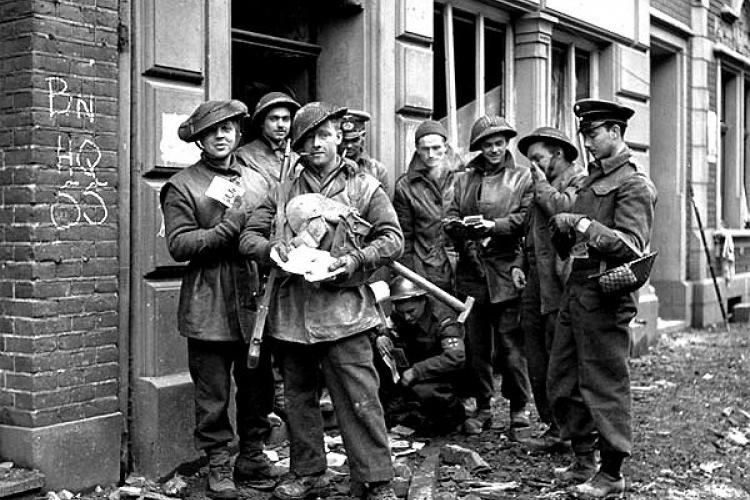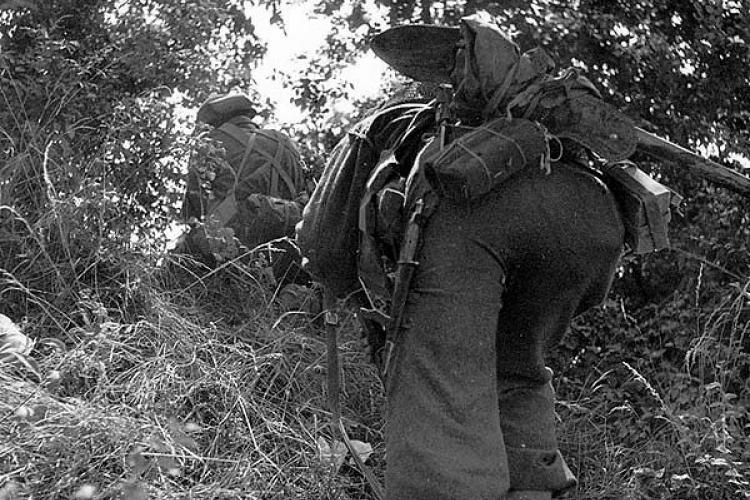Divisional Unit
Awards
SERVICE NO: A / 59440
AWARDS: 1939-45 Star, France – Germany Star – Defence Medal –
War Medal – Canadian Volunteer Service Medal + clasp.
DATE OF BIRTH: September 26, 1918 – Guelph – County of Wellington – Ontario.
DATE OF DEATH: February 11, 1945 26 years 4 months.
FATHER: Mr. Thomas Ryan – Parkhill – Ontario.
BROTHERS: Mr. Norman Ryan – Parkhill – Ontario.
Mr. Hugh Ryan – Petrolia – Ontario.
CEMETERY: Temporary Canadian Military Cemetery – Nijmegen – Netherlands.
Plot 1 Row 5 Grave 18.
Height: 5’ 8” Weight: 145 pounds
Complexion: medium Eyes: blue Hair: grey/black
Occupation: Bus Operator Religion: Roman Catholic
RESIDENCE: Parkhill - Ontario
ENLISTMENT: March 12, 1942 – London – Ontario.
ENLISTMENT AGE: 23 years 5 months
Thomas received his primary education and graduated from Grade 8 and then took 1 year of High School.
Private Ryan’s Service File states that he lived in Corbett and this where he received his primary education.
His service file also states that Thomas had lived in Huron County for a period of time.
- Thomas had enrolled in the Non Permanent Active Militia of Canada on October 9, 1940 into the Huron & Middlesex Regiment.
- Thomas enlisted under the National Resource Mobilization Act for Home Defence in London on March 12, 1942.
- March 21, 1942 – to No. 10 Basic Training Centre in Chatham – Ontario.
- March 25, 1942 – Private Ryan enlists into the Canadian Active Service Force in Chatham – Ontario.
- April 7, 1942 – to No. 8 Infantry Training Centre at Camp Borden – Ontario.
- July 17, 1942 – Struck off Service to Canadian Forces overseas.
- July 21, 1942 – Private Ryan departed from Canada bound for overseas.
- July 21, 1942 – appointed to the Rank of Trooper.
- July 30, 1942 – Trooper Ryan arrived in the United Kingdom.
- September 1, 1942 – granted leave to September 8, 1942 United Kingdom
- November 27, 1942 – granted leave to December 6, 1942. “
- February 25, 1943 – attached to the 7th Reconnaissance Regiment. “
- March 22, 1943 – granted leave to March 29, 1943. “
- June 14, 1943 – proceeds to Canadian Military Headquarters for a course. “
- September 22, 1943 – returned from course at Canadian Military Headquarters.
- October 7, 1943 – attached to the 28th Armoured Regiment. “
- January 28, 1944 – to No. 3 Canadian Armoured Corp Reinforcement Unit “
- February 5, 1944 – qualified as a Deiver I.C. Class II wheeled vehicles “
- August 2, 1944 – is a qualified Driver / Mechanic MU “C” “
- October 16, 1944 – Trooper Ryan leaves the United Kingdom for the continent.
- October 17, 1944 – arrives in Belgium
In the field….
- October 18, 1944 – transferred to the Highland Light Infantry of Canada, North-West Europe
- On November 11, 1945, the Regiment was on the Dutch – German border and on a ridge between Nijmegen and Arnhem they took up their positions. Once again, they were living in the cold and damp earth with living quarters being dug into the ground, and pieces of derelict gliders provides roofs for the infantry.
Put in front of them was a no man’s land of shell craters and water, with the derelict gliders scattered across the landscape and maybe a war - torn house or barn.
The next months would prove to be tedious, cold and a miserable life. There would be no advances until February 1945.
- OPERATION VERITABLE began on February 8, 1945, with 3rd Canadian Division and three British Divisions on the flooded left bank over the Waal Flats. The old city of Cleve was bombed flat, and the heaviest artillery bombardment of the war came down upon the enemy positions.
The Materborn Gap was the key to everything and it was 3,300 yards of open ground and it stretched from Cleve and the forests of the Hochwald to the south.
By February 9, 1945, the 3rd Canadian Infantry Division whose sector covered more than half the front began to advance and take their objectives on by one. However, the water was rising and the 7th & 8th Brigades found themselves cut off from their objectives and the 9th Brigade had to complete the role of the Division during this initial phase of the advance.
During phase two the British had penetrated the enemy defences south of the Cleve – Nijmegen Road but were now facing delays in advancing because of the water and rain. As Phase 2 progressed the British were 11 hours behind and the Final phase was to begin before the enemy had a chance to begin reinforcing.
The Final phase was the capture of the Materborn Heights overlooking Cleve. In the evening, the British reported that the enemy forces in Cleve seems disorganized and may not offer much resistance. It was a different story to the south the way seemed to be blocked by a coordinated enemy defence of the Materborn village.
- On February 10, 1945, the Regiment began to advance over the terrain that stopped the artillery from offering their support. The Regiment was stopped by enemy machine gun fire from pill boxes outside the village of Duffelward and this was the only approach. They dug in here for the night.
On the morning of February 11, 1945, the Highland Light Infantry advanced onto Duffelward. By mid afternoon, the Regiment occupied Wardhausen and by evening the Stormont, Dunas & Glengarry Highlanders and the Highland Light Infantry were in control of the Spoy Canal.
In March 1945, Private Ryan’s father received a letter from a comrade of his son stating that when the Regiment was at the front between Nijmegen and Arnhem stating that they used to play cards together.
The letter stated that Private Ryan was a member of No. 2 Platoon and that he was a Bren gunner.
Following the war, another letter arrived from this comrade of Private Ryan and at that time he states that on February 11, 1945, things began to happen quickly following the orders to advance. No. 2 Platoon was part of that advance, quite possibly onto the village of Kleef. No 2 Platoon came under very heavy enemy machine gun fire and 50% + casualties were received.
Private Ryan was apparently killed instantly and he fell in battle at about 4:30 pm during the afternoon of February 11, 1945. He was advancing and firing his Bren gun when he fell.
- The father of Private Ryan received a Canadian Pacific Telegraph dated February 20, 1945 informing him that his son had been killed in action.
- Brigadier A. C. Spencer per the Adjutant General wrote a letter to Mr. Ryan on February 27, 1945 expressing condolences on the death of his son her who been killed serving his country in the North=West Europe theatre of war. The letter further stated that sympathies were being forwarded from the Minister of Defence and the Army Board.
- A letter was received by Mr. Ryan dated August 3, 1946 informing him that Private Ryan he been reburied with honours and Christian rites at Groesbeek Canadian War Cemetery and that should he wish to send a short and personalized inscription it would be placed on the headstone. This was from Colonel C. L. Laurin, the Director of Records per the Adjutant General.
Mr. Ryan received a letter written on January 21, 1948 which had a photograph enclosed showing the cemetery and grave stone of his son.
Thomas was insured with Monarch Life Assurance Company and Great West Life Association Company.
The personal effects of Private Ryan were photos, leather wallet, pen and a pocket watch with chain.
There was $22.18 in his personal effects. As well, he had purchased $50 in Victory Bonds.
His War Service Gratuity was $488.73 and his Last Pay amounted to $283.32.



